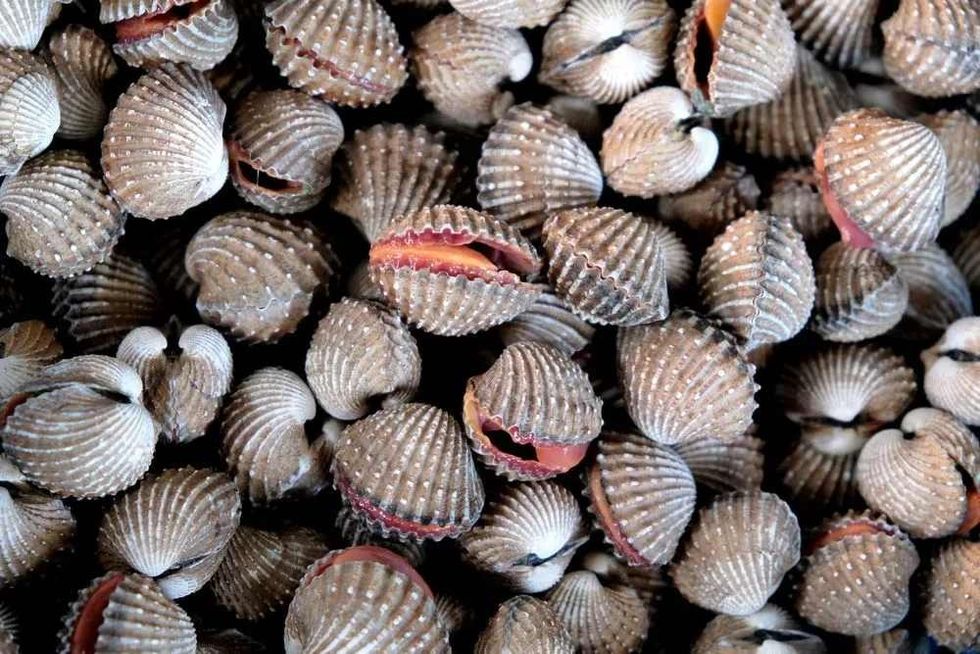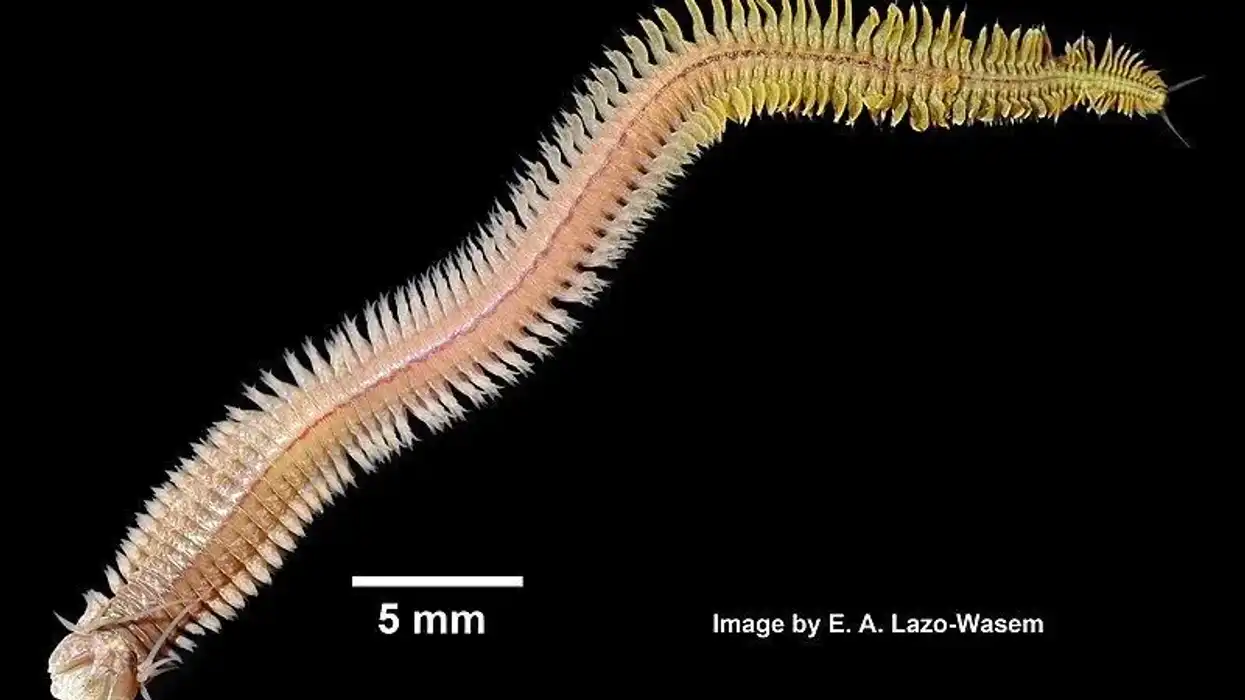Cockles (Cerastoderma edule) are tiny clams that are found in saltwater. They are also are edible, which is, in fact, why they are so popular. Cockles have a small heart-like shell that packs a salty and soft flesh that is a delicacy for many worldwide.
Cockles, also known as heart clams, belong to the family Cardiidae and genus Cardium and are bivalve mollusks. Bivalve mollusks have two 'valves', meaning two parts and there are about 250 species of cockles!
When seen from an end, the distinctive rounded shells are bilaterally symmetrical and heart-shaped. What a cute shape, right? In most genera, the shell has several radials and has uniformly spaced ribs.
They are found across the world and range in size from 0.4-6 in (1-15 cm), roughly the same size as the smooth giant cockle (Laevi-cardium elatum) of California. This species lives just below the low tide level, but some have been found at depths of over 1,500 ft (500 m), and a few live in the intertidal zone too.
Many of them are present in sandy or muddy environments, shallowly buried to a depth of 1 in (3 cm) or less.
The shell's two valves are of similar size and shape, and their colors vary from brown to red or yellow. Some species have smooth shells, while some have ribs that radiate from the hinge region between the shells.
Cockle shells can close completely.
While the ribs on a cockle's shell resemble those on a scallop, Cockles are differentiated from scallops morphologically by the absence of 'auricles' (triangular ear-shaped projections along the joint) and the absence of a pallial sinus on scallop shells.
Cockles live submerged in sediments, while scallops are either free-living, capable of diving into the water column to escape a predator, or live bound to a substrate by a byssus.
There are many different types of cockles. Cockles such as the Cerastoderma edule, the common cockle, and the dog cockle are inedible. Egg cockle is known as the 'true cockle', and blood cockles are common in Korea and Malaysia. True cockles can be found on dry, sheltered beaches all around the world.
You can also visit our articles on the hermit crab and the barnacle to learn more about different sea creatures.
Cockle Interesting Facts
What type of animal is a cockle?
Cockles are marine bivalve mollusks that are edible.
What class of animal does a cockle belong to?
The cockle belongs to the class of Bivalvia and the family of Cardiidae.
How many cockles are there in the world?
There are about 250 species of cockles, but their exact population is unknown.
Where does a cockle live?
Cockles live in the ocean. This species lives just below the low tide level, but some have been found at depths of over 1,500 ft (500 m), and a few live in the intertidal zone.
What is a cockle's habitat?
The typical cockle habitat consists of soft mud and fine sand in subtidal areas. They prefer larger grain size sediments and are usually found in sand flats and eelgrass beds.
They have been found in water depths of up to 65 ft (20 m) in some places, but they prefer shallower environments. Cockles also live in estuaries and can withstand certain salinity increases.
Who do cockles live with?
Cockles are creatures that live freely and usually alone in solitude.
How long does a cockle live?
The lifespan of a cockle clam ranges from five years to 10 years.
How do they reproduce?
Many cockle species' breeding seasons last several months. Fertilization happens as eggs and sperms are shed into the ocean. Once fertilization is complete, the young larvae form and build their shells and swim freely. After this, they metamorphose at the bottom. Cockles eat small creatures that they encounter in the water.
What is their conservation status?
The conservation status of the cockle is Least Concern, which means we do not have to worry about their population declining. Great news, right?
Cockle Fun Facts
What do cockles look like?
Cockles have two shells inside which they live. When held sideways, a cockle has a distinct heart shape. The cockle also has a ribbed texture over it. Inside the shell, the flesh is gray, but this can vary depending on the species. They can grow up to 0.4-6 in (1-15 cm) in size.
How cute are they?
Some sea cockle shells are beautiful. They usually have unique color patterns, and their ribbed texture is the cherry on top. They are often cleaned and sold as souvenirs or gifts, but aren't often described as cute.
How do they communicate?
Information on their way of communication is not currently known.
How big is a cockle?
They range in size from 0.4-6 in (1-15 cm), roughly the same size as the California Smooth Giant Cockle (Laevicardium elatum). The shell's two valves are of similar size and shape, and their colors vary from brown to red or yellow.
How fast can cockles move?
The speed of cockles is nearly zero as they rarely move and simply reside on the muddy shore.
How much does a cockle weigh?
The weight of cockles is normally around 0.88 oz (25 g)
What are their male and female names of the species?
No specific names are given to males and females of this species.
What would you call a baby cockle?
There are no specific names for baby cockles.
What do they eat?
The typical cockle diet consists of phytoplankton that they eat by pumping water through their gills in an attempt to catch these tiny plants (called phytoplankton). Phytoplankton is then moved towards their mouths. This procedure to eat their food is known as filter-feeding.
Are they harmful?
No, they are not harmful; in fact, they are edible and are used in multiple cuisines. Sometimes, they do pose a danger of indigestion and sometimes food poisoning if they are not cooked correctly.
Would they make a good pet?
They would not make a good pet as they rarely move and are mostly used in various cuisines. Their shells could make good souvenirs or gifts, though.
Did you know...
Discover some cockle shell fun facts here. For example, did you know that cockles can be found on sandy and protected beaches in the world?
When seen from certain angles, cockles have distinguishing spherical shells that are symmetrical and heart-shaped. There are multiple radial ribs in most genera (ridges on the shell) and the egg cockle of the genus Laevicardium has a very smooth shell.
One of the more interesting cockle shell facts is that a Cockle can 'hop' by flexing and unfolding its feet.
The giant Atlantic cockle, also known as the great heart cockle (Dinocardium robustum) is about 6 in (15.24 cm) long.
Do cockles have eyes?
A cockle, like most bivalves, does not have a head. Cockles also do not have eyes or a brain. They have a mouth, kidneys, a heart, a circulatory system, and an anus.
Cockle vs. clam
The key distinction between a clam and a cockle is that the former can be found in both saltwater and freshwater habitats, whilst cockles can only be found in saltwater. They are briny mollusks that like to live in saltwater.
The term clam is used in a general sense, while cockle is used in a more specific way and the general shape of each mollusk's shell varies considerably. A cockle has a slightly ribbed oval or heart-shaped shell.
Their shell has distinct markings that make them easy to distinguish from clams which, on the other hand, come in several shapes and sizes, including triangular, circular, and elongated.
Clams are suitable for raw consumption, but raw cockle, on the other hand, is not recommended. Steamed with butter and lemon dressing is the perfect way to eat them. Consuming a raw cockle can cause food poisoning and other health problems. Cockles also tend to be more flavorsome than clams.
A clam is much larger than a cockle and since the cockle is a member of the clam family, every cockle is a clam, but every clam is not a cockle.
Eating cockles
An easy cockle recipe is as follows: bring a cup of water to a boil with a dash of lemon or white wine vinegar for an acidic touch. Season with salt or pepper as you'd like.
Cover the cockles on the pan with a lid. It'll just take a few minutes for them to cook, and then the shell will pop open. The orange cockle meat can then be conveniently extracted and consumed.
Freshly cooked sea cockle snacks are sold in the U.K., especially along the British coast, where marine cockles are found in abundance. They can be purchased, boiled, and seasoned with acidic vinegar and black/white pepper from seafood stalls.
Pickled cockles are available in cans and sealed in packages (with vinegar) featuring a two-pronged plastic fork. A standard Welsh breakfast consists of cockles served alongside bacon and eaten with laverbread. Yummy!
Here at Kidadl, we have carefully created lots of interesting family-friendly animal facts for everyone to discover! Learn more about some other arthropods, including the giant water bug or the ground beetle.
You can even occupy yourself at home by drawing one on our cockle coloring pages.










